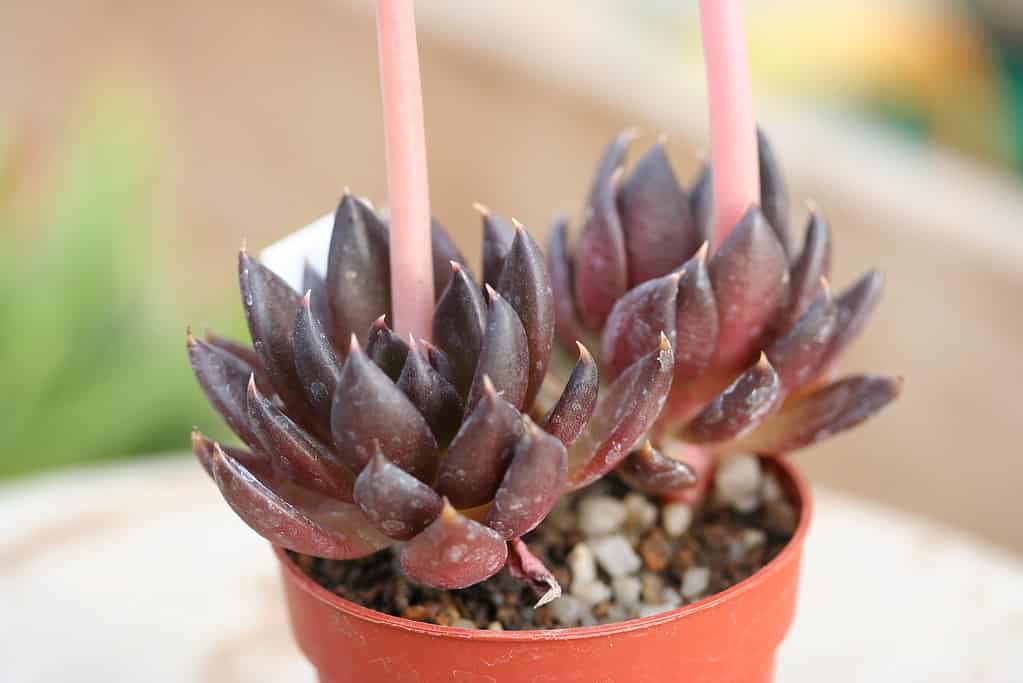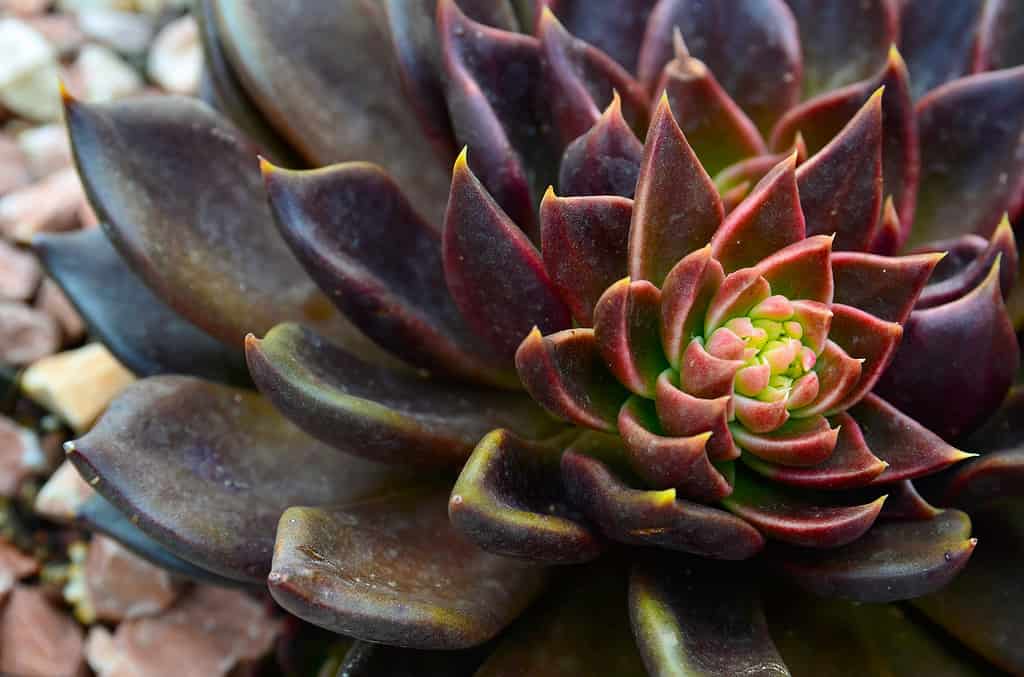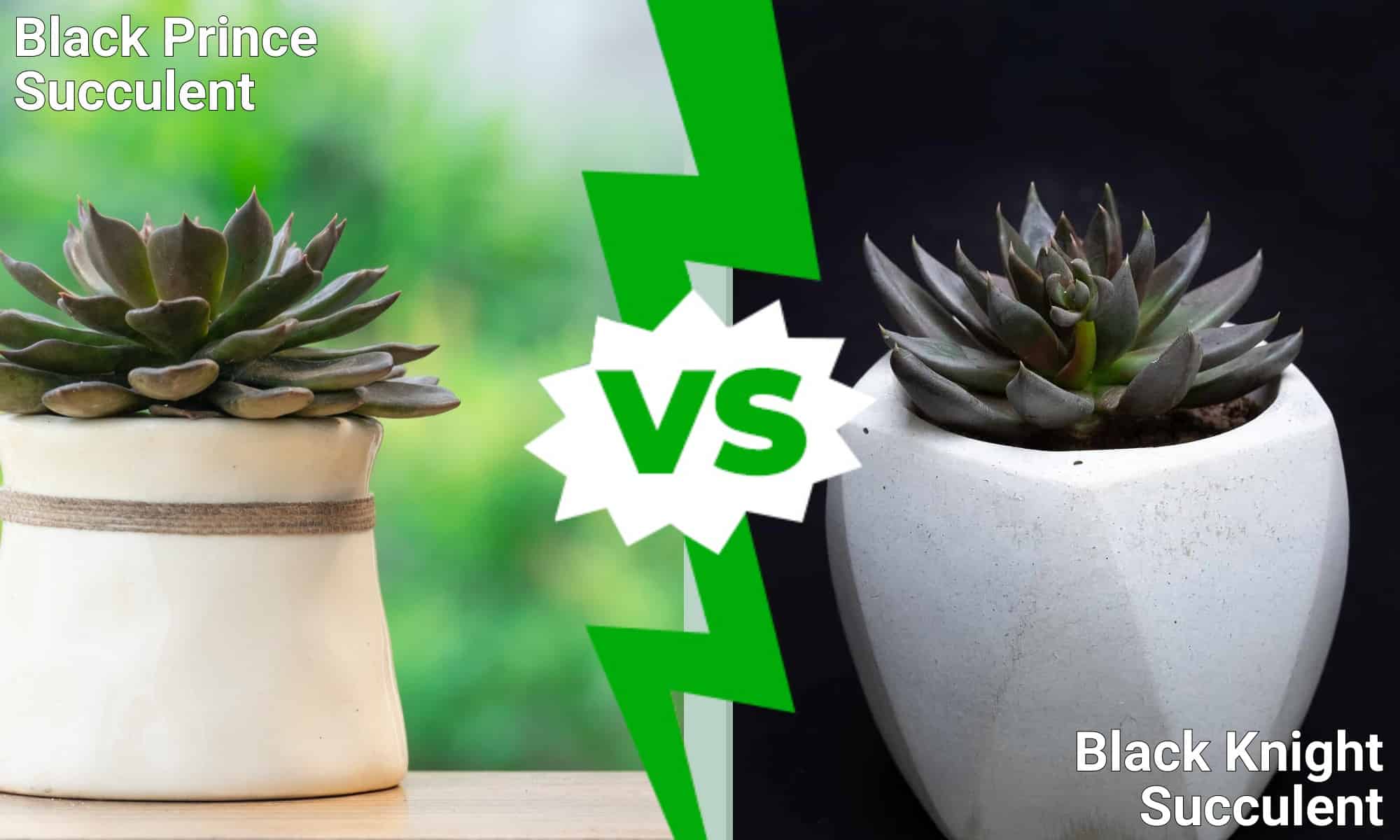There’s nothing like black succulents to add a touch of goth glam to your garden. They’re easy to care for, beautiful to look at, and simple to propagate.
The Black Prince and Black Knight are two similar Echeveria cultivars that look the same at a glance but have distinct differences up close. In this article, we’ll discuss the differences so you know which dark beauty you’re adding to your collection.
Comparing Black Prince vs. Black Knight Succulent
| Black Prince | Black Knight | |
|---|---|---|
| Classification | Echeveria ‘Black Prince’ | Echeveria affinis ‘Black Knight’ |
| Alternative Names | dark prince succulent, black hen and chicks | N/A |
| Origin | Mexico, California | Mexico |
| Description | Flat, triangular leaves sprout in green around the middle and blacken as they grow and photosynthesize. Grows up to 3-6 inches tall and 4-8 inches wide. Grows red flowers on stalk from center of rosette with proper care. | Narrow, triangular, tubular leaves grow upward and curve inward toward the center of the rosette. Leaves sprout in green around the middle and darken to an inky black as they grow and photosynthesize. Grows up to 3-5 inches tall and 4-6 inches wide. Blooms with a red flower on stalk from center of the rosette with proper care. |
| Growth Tips | Requires well-draining soil and full sunlight. Can be grown outdoors in USDA Zones 9-11. Propagation can occur through transplanting offsets or taking leaf cuttings. | Requires well-draining soil and full sunlight. Can be grown outdoors in USDA Zones 10-11. Propagation can occur through transplanting offsets or taking leaf cuttings. |
| Interesting Features | This plant is a hybrid of Echeveria shaviana and Echeveria affinis ‘Black Knight’. It often resembles Echeveria shaviana more prominently, with leaves staying a deep pinkish brown rather than darkening to black. | The International Crassulaceae Network (ICN) no longer recognizes the cultivar Echeveria ‘Black Knight’, as it’s been determined as a naturally occurring coloration of the Echeveria affinis. However, this nickname is still used frequently in shops and by plant lovers. |
Black Prince vs. Black Knight Succulent: Key Differences
While the Black Prince and Black Knight succulent are closely related, their appearances show notable differences.
The Black Prince tends to be lighter with a more pink or brown hue than the deep, jet-black tone of the Black Knight. This difference results from the Black Prince’s hybrid status, as its other parent plant, the Echeveria shaviana, has blush tones.
The Black Prince is a hybrid of Echeveria shaviana and Echeveria affinis ‘Black Knight.’ Conversely, Echeveria affinis ‘Black Knight’ is a naturally occurring species. In fact, the ICN doesn’t recognize the Black Knight succulent as a unique cultivar and labels it as its true species, Echeveria affinis.
The leaf shapes are also quite different between the Black Prince and Black Knight succulent. The Black Prince has flat, triangular leaves that grow outward.
The Black Knight has tubular leaves that grow upward and inward toward the center of the rosette. These leaves appear sharper and lance-like. Collectors believe the similarities to a knight’s lance earned the Black Knight its name.

The Black Knight has tubular leaves that grow upward and inward toward the center of the rosette.
©Michael Wolf, CC BY-SA 3.0, via Wikimedia Commons – Original / License
Black Prince vs. Black Knight Succulent: Classification
The Black Prince is classified as Echeveria ‘Black Prince’ as it is a hybrid of Echeveria shaviana and Echeveria affinis rather than a unique species.
The Black Knight is officially classified as Echeveria affinis, though it’s often listed as Echeveria affinis ‘Black Knight.’ These plants are closely related, as the Black Knight is a parent plant to the Black Prince.
Black Prince vs. Black Knight Succulent: Origin
Echeverias originate from Mexico and Central America, preferring a warm, dry climate.
The Black Prince hybrid is believed to have been discovered by nurseryman Frank Reinelt in Capitola, California, in the mid-20th century.
Reinelt was known for his expertise in growing and hybridizing succulent plants, particularly Echeveria and Aloe species. This notoriety led to the development of another Echeveria cultivar known as Echeveria agavoides ‘Frank Reinelt.’
Black Prince vs. Black Knight Succulent: Description
The Black Prince reigns supreme with its dark, regal appearance. The rosette boasts plump, perfectly arranged leaves that resemble a crown fit for a prince. As the Black Prince matures, the outer leaves may take on a reddish or bronze hue.
When the Black Prince blooms, it produces a tall stalk with delicate red-pink flowers that seem to float above the darkness of the foliage like a dreamy cloud. This succulent grows no more than 6 inches tall and 8 inches wide when it produces
The Black Knight succulent has a dark and moody allure. Its leaves boast a distinct lanceolate shape that tapers to a point, deepening from a vibrant green to the center of the rosette to a deep black.
If you’re lucky enough to see the Black Knight succulent in bloom, you’ll see delicate coral-red flowers that seem to glow against the darkness of the foliage. This small succulent grows no more than 5 inches high and 4 inches wide, producing offshoots as it matures.

The Black Prince succulent has flat, triangular leaves that grow outward.
©iStock.com/svf74
Black Prince vs. Black Knight Succulent: Growth Tips
The Black Prince and Black Knight prefer full, direct sunlight despite their dark and gloomy appearance. The more sunlight they receive, the darker they’ll become.
Like other species of Echeveria, both the Black Prince and Black Knight are prone to root rot and require well-draining potting soil. Use a succulent soil blend, or create your own with potting soil, sand, and perlite. Water infrequently, allowing the top inch of soil to dry completely between. Both the Black Prince and Black Knight succulent go through a dormant period in the winter, during which watering needs to lessen.
The Black Prince and Black Knight need plenty of airflow to encourage growth, so propagate and transplant pups annually to prevent overcrowding. While these plants can grow in a terrarium, it’s best to use a roomy vessel with a large opening.
The Black Prince and Black Knight generally don’t require fertilizer or plant food. However, putting organic compounds in their soil and repotting bi-annually will help with nutrient production and retention.

The more sunlight the Black Prince and Black Knight receive, the darker they’ll become.
©Inna Reznik/Shutterstock.com
Thank you for reading! Have some feedback for us? Contact the AZ Animals editorial team.








